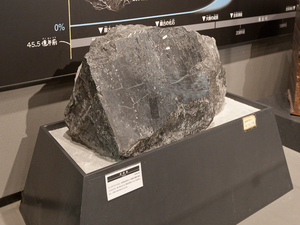Nagoya City Science Museum
TOP > Exhibition Guide > Keyword Search > Starting with "C" > carbon dioxide > Storage of Ancient Carbon Dioxide
Storage of Ancient Carbon Dioxide



Purpose of Exhibition
Abnormally low atmospheric carbon dioxide concentration is specific to the Earth's environment. In the remote past, carbon dioxide was transformed into a certain rock. Life on the Earth was involved in the limestone formations. The exhibit is symbolic of limestone that gets across to us that the Earth's life has created the present global environment.
Additional Knowledge
Venus and Mars, the two planets on both sides of the Earth, both have an atmosphere consisting predominantly of carbon dioxide. Don't you think that it is strange that the Earth located between them has an atmosphere almost free of carbon dioxide? As a matter of fact, the Earth's atmosphere once consisted mostly of carbon dioxide. Oh! Yes, the Earth was one of the "three CO? sister planets." Despite the fact that the ancient Earth's atmosphere consisted mostly (97 to 98%) of carbon dioxide before and for a certain period of time after the oceans were formed, the present-day Earth's atmosphere contains an extremely small volume (0.035%) of carbon dioxide. If so, where did that enormous volume of carbon dioxide go from the ancient Earth's atmosphere? Its volume was tens of thousands of times higher than that of the carbon dioxide present in today's atmosphere.
In fact, the carbon dioxide was transformed into a certain rock ‐ limestone. Should all the limestone currently existing on the Earth be transformed back into carbon dioxide, the atmospheric carbon dioxide concentration would be as high as 97 to 98% with an atmospheric pressure of 30 and would be much the same as that of Venus. In other words, thanks to the transformation of most of the atmospheric carbon dioxide into limestone, the Earth's atmosphere contains an extremely small volume of carbon dioxide. If the massive volume of carbon dioxide had not been removed from the atmosphere, the green house effect would have transformed the Earth into a blazing inferno. So limestone may be referred to as carbon dioxide storage.
Now, take a good look at the limestone on exhibit. It contains fossil corals and fossil animals such as Fusulina. Limestone is the time-hardened remains of calcareous shell-wearing animals. So it can also be viewed as the life-created specialty stone of the Earth.
The formation of the oceans on the Earth was the biggest factor in removing the enormous volume of carbon dioxide from the atmosphere. That is because carbon dioxide is easily soluble in water. Specifically, the carbon dioxide that dissolved in the oceans was inorganically precipitated through its reactions with calcium ions, etc. However, it alone was not effective enough to reduce the atmospheric carbon dioxide substantially. Fortunately, calcareous shell-wearing living things including corals then emerged to consume the carbon dioxide dramatically. Those living things tremendously consumed the carbon dioxide to build their bone structures. The corals eventually created huge calcareous masses called coral reefs. Subsequently, the coral reefs spent ages gradually turning into limestone. As much carbon dioxide further dissolved in the oceans as the living things consumed. In this manner, the enormous volume of carbon dioxide was eliminated from the atmosphere over an immeasurably long period of time.
Article by Shoji Nishimoto, curator
